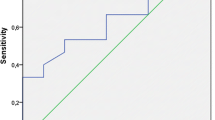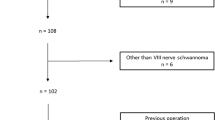Abstract
Background
Decision-making for large sporadic vestibular schwannomas (VS) resection guided by the intraoperative change in supramaximal facial nerve (FN) amplitude and latency response to optimize post-operative FN outcome.
Methods
Prospectively study of 43 patients, from January to December 2018, of large sporadic VS with preoperative normal FN function at our center. Tumors were removed through retrosigmoid (81%) or translabyrinthine (19%) approaches with FN monitoring. Intraoperative pre- and post-VS resection supramaximal (2 mA) amplitude and latency responses at the proximal FN root were recorded.
Results
Total, near-/subtotal VS resections (TR, NTR, STR) were achieved in 51%, 38%, and 11% of tumors, respectively, guided by no more than 40% decrease in supramaximal amplitude. Pre- and post-resection supramaximal amplitude and latency responses were lower and longer, respectively, in NTR+STR than in TR. At day 8, FN function was grade I–II in 77% of patients and grade III–V in 23%, and after 6 months, it was in grade I-II in 95% and grade III in 5%, and there was no significant difference between TR and NTR+STR. Facial palsy occurred in older patients and in the case of severe FN adhesion. At day 8, pre- and post-resection supramaximal amplitude but not latency responses were different between FN grade III-V and grade I-II. Serviceable hearing was preserved in 28% of large VS.
Conclusions
Intraoperative FN monitoring guided VS resection in large VS so that 49% retained some residual tumor. Accordingly, 95% good postoperative FN function and significant hearing preservation were achieved after 6 months.


Similar content being viewed by others
References
Acioly MA, Liebsch M, de Aguiar PH, Tatagiba M (2013) Facial nerve monitoring during cerebellopontine angle and skull base tumor surgery: a systematic review from description to current success on function prediction. World Neurosurg 80:e271–e300
Bernardeschi D, Pyatigorskaya N, Vanier A, Bielle F, Smail M, Lamas G, Sterkers O, Kalamarides M (2018) Role of electrophysiology in guiding near-total resection for preservation of facial nerve function in the surgical treatment of large vestibular schwannomas. J Neurosurg 128:903–910
Bernat I, Grayeli AB, Esquia G, Zhang Z, Kalamarides M, Sterkers O (2010) Intraoperative electromyography and surgical observations as predictive factors of facial nerve outcome in vestibular schwannoma surgery. Otol Neurotol 31:306–312
Bloch O, Sughrue ME, Kaur R, Kane AJ, Rutkowski MJ, Kaur G, Yang I, Pitts LH, Parsa AT (2011) Factors associated with preservation of facial nerve function after surgical resection of vestibular schwannoma. J Neuro-Oncol 102:281–286
Breshears JD, Morshed RA, Molinaro AM, McDermott MW, Cheung SW, Theodosopoulos PV (2020) Residual tumor volume and location predict progression after primary subtotal resection of sporadic vestibular schwannomas: A retrospective volumetric study. Neurosurgery 86:410–416
Daoudi H, Lahlou G, Degos V, Sterkers O, Nguyen Y, Kalamarides M (2020) Improving facial nerve outcome and hearing preservation by diferente degrees of vestibular schwannoma resection guided by intraoperative facial nerve electromyography. Acta Neurochir 162:1983–1993
Esquia-Medina GN, Grayeli AB, Ferrary E, Tubach F, Bernat I, Zhang Z, Bianchi C, Kalamarides M, Sterkers O (2009) Do facial nerve displacement pattern and tumor adhesion influence the facial nerve outcome in vestibular schwannoma surgery. Otol Neurotol 30:392–297
Grayeli AB, Kalamarides M, Bouccara D, Rey A, Sterkers O (2003) Functional staging of acoustic neuromas. In: Kanzaki J, Tos M, Sanna M, Moffat DA, Kunihiro T, Inoue Y (eds) Acoustic Neuroma. Keio University International Symposia for Life Sciences and Medicine. Springer, Tokyo, pp 141–146
Grayeli AB, Guindi S, Kalamarides M, El Garem H, Smail M, Rey A, Sterkers O (2005) Four-channel electromyography of the facial nerve in vestibular schwannoma surgery: sensitivity and prognostic value for short-term facial function outcome. Otol Neurotol 26:114–120
Gurgel RK, Theodosopoulos PV, Jackler RK (2012) Subtotal/near-total treatment of vestibular schwannomas. Curr Opin Otolaryngol Head Neck Surg 20:380–384
House JW, Brackmann DE (1985) Facial nerve grading system. Otolaryngol Head Neck Surg 93:146–147
Jacob JT, Carlson ML, Driscoll CL, Link MJ (2016) Volumetric analysis of tumor control following subtotal and near-total resection of vestibular schwannoma. Laryngoscope 126:1877–1882
Liu SW, Jiang W, Zhang HQ, Li XP, Wan XY, Emmanuel B, Shu K, Chen JC, Chen J, Lei T (2015) Intraoperative neuromonitoring for removal of large vestibular schwannoma: Facial nerve outcome and predictive factors. Clin Neurol Neurosurg 133:83–89
No Authors (1995) Committee on Hearing and Equilibrium guidelines for the evaluation of hearing preservation in acoustic neuroma (vestibular schwannoma). American Academy of Otolaryngology-Head and Neck Surgery Foundation, INC. Otolaryngol Head Neck Surg 113:179–180
Schmitt WR, Daube JR, Carlson ML, Mandrekar JN, Beatty CW, Neff BA, Driscoll CL, Link MJ (2013) Use of supramaximal stimulation to predict facial nerve outcomes following vestibular schwannoma microsurgery: results from a decade of experience. J Neurosurg 118:206–212
Taha I, Hyvärinen A, Ranta A, Kämäräinen OP, Huttunen J, Mervaala E, Löppönen H, Rauramaa T, Ronkainen A, Jääskeläinen JE, Immonen A, Danner N (2020) Facial nerve function and hearing after microsurgical removal of sporadic vestibular schwannomas in a population-based cohort. Acta Neurochir 162:43–54
Torres R, Nguyen Y, Vanier A, Smail M, Ferrary E, Sterkers O, Kalamarides M, Bernardeschi D (2017) Multivariate Analysis of Factors Influencing Facial Nerve Outcome following Microsurgical Resection of Vestibular Schwannoma. Otolaryngol Head Neck Surg 156:525–533
Yang J, Grayeli AB, Barylyak R, Elgarem H, Kalamarides M, Ferrary E, Sterkers O (2008) Functional outcome of retrosigmoid approach in vestibular schwannoma surgery. Acta Otolaryngol 128:881–886
Zhang Z, Nguyen Y, De Seta D, Russo FY, Rey A, Kalamarides M, Sterkers O, Bernardeschi D (2016) Surgical treatment of sporadic vestibular schwannoma in a series of 1006 patients. Acta Otorhinolaryngol Ital 36:408–414
Zhu W, Chen H, Jia H, Chai Y, Yang J, Wang Z, Wu H (2018) Long-term hearing preservation outcomes for small vestibular schwannomas: retrosigmoid removal versus observation. Otol Neurotol 39:e158–ee65
Acknowledgements
We gratefully thank Amgad Hamza (S&S for Biostatistical Analysis, Alexandria, Egypt) for assistance with statistical analysis.
Funding
Mohamed Elsayed was provided financial support in the form of Ministry of Higher Education, Mission sector, Egypt (http://www.mohe-casm.edu.eg) and the Ministry of Scientific Research.
Huan Jia was provided financial support in the form of Shanghai Scientific and Technological Innovation Action Plan (17441903600), and Shanghai Key Laboratory of Translational Medicine on Ear and Nose diseases. (14DZ2260300). The sponsor had no role in the design or conduct of this research.
Author information
Authors and Affiliations
Corresponding authors
Ethics declarations
Ethical approval
All procedures performed in studies involving human participants were in accordance with the ethical standards of the institutional and/or national research committee (name of institute/committee) and with the 1964 Helsinki declaration and its later amendments or comparable ethical standards. Institutional review board approval was obtained from the Ethics Committee of Comite De Protection Des Personnes–Ile de France VI, Groupe Hospitalier Pitié-Salpêtrière (CNIL Authorization No.: 2211758).
Conflict of interest
All authors certify that they have no affiliations with or involvement in any organization or entity with any financial interest (such as honoraria; educational grants; participation in speakers' bureaus; membership, employment, consultancies, stock ownership, or other equity interest; and expert testimony or patent-licensing arrangements), or non-financial interest (such as personal or professional relationships, affiliations, knowledge, or beliefs) in the subject matter or materials discussed in this manuscript.
Additional information
Publisher’s note
Springer Nature remains neutral with regard to jurisdictional claims in published maps and institutional affiliations.
This article is part of the Topical Collection on Tumor - Schwannoma
Rights and permissions
About this article
Cite this article
Elsayed, M., Jia, H., Hochet, B. et al. Intraoperative facial nerve electromyography parameters to optimize postoperative facial nerve outcome in patients with large unilateral vestibular schwannoma. Acta Neurochir 163, 2209–2217 (2021). https://doi.org/10.1007/s00701-021-04814-2
Received:
Accepted:
Published:
Issue Date:
DOI: https://doi.org/10.1007/s00701-021-04814-2




